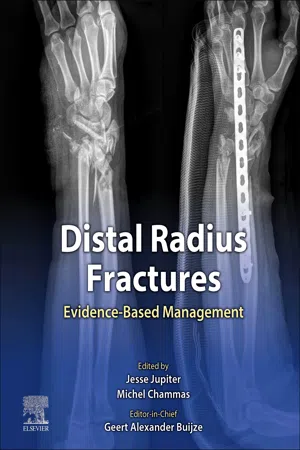
Distal Radius Fractures
Evidence-Based Management
- 458 pages
- English
- ePUB (mobile friendly)
- Available on iOS & Android
Distal Radius Fractures
Evidence-Based Management
About this book
Edited and authored by leading international experts, Distal Radius Fractures: Evidence-Based Management provides a state-of-the-art overview of diagnosis and management based on today's best practices. Each chapter focuses on one key issue, offering a challenging case and then questioning the reader in an engaging fashion to provide the best available evidence on each topic. Practical and easy to read, this innovative text is a useful resource for all residents, physicians and surgeons who manage fractures.- Combines current best practices with the knowledge and experience of a global team of expert contributing authors, with a focus on practical use in applying the evidence.- Covers need-to-know topics such as anatomy and biomechanics, diagnostic management, acute fracture management, management of pediatric and elderly fractures, and more.- Includes valuable case scenarios, technical tips and tricks, and pearls and pitfalls.- Features high-quality illustrations including CT scans, x-rays, and clinical photographs.- Consolidates the latest evidence on distal radius fractures into one convenient resource.
Frequently asked questions
- Essential is ideal for learners and professionals who enjoy exploring a wide range of subjects. Access the Essential Library with 800,000+ trusted titles and best-sellers across business, personal growth, and the humanities. Includes unlimited reading time and Standard Read Aloud voice.
- Complete: Perfect for advanced learners and researchers needing full, unrestricted access. Unlock 1.4M+ books across hundreds of subjects, including academic and specialized titles. The Complete Plan also includes advanced features like Premium Read Aloud and Research Assistant.
Please note we cannot support devices running on iOS 13 and Android 7 or earlier. Learn more about using the app.
Information
Chapter 7: Closed Reduction and Immobilization of Displaced Distal Radius Fractures
Abstract
Keywords
- • Despite the popularity of surgical treatment, most displaced distal radius fractures (DRFs) are initially managed with closed reduction and immobilization.
- • Radiological outcomes were not significantly different between mechanical reduction using finger-trap traction and manual reduction.
- • Compared to procedural sedation, local anesthesia (hematoma block) is a safe and effective alternative anesthesia for reduction of DRFs, which provides excellent pain relief in adult and pediatric patients.
- • Immobilization using a sugar-tong or above-the-elbow splint is equivalent to a short-arm splint for maintaining the reduction and quality of molding has more influence on maintaining reduction than the length of the cast.
- • The evidence of the benefit of routinely repeating reduction or routine preoperative reduction in DRFs is insufficient
- • Repeated reduction should be reserved for experienced teams in selected patients, such as those with minimal comminution, those who fail to get appropriate reduction due to inadequate anesthesia or those who have relative contraindications to surgery.
Importance of the Problem
Main Question
Current Opinion
Table of contents
- Cover image
- Title page
- Table of Contents
- Copyright
- Dedication
- Section Editors
- Contributing Authors
- Preface
- Section I: Introduction
- Section II: Anatomy and Biomechanics
- Section III: Diagnostic Management
- Section IV: Acute Fracture Management
- Section V: Pediatric Fracture Management
- Section VI: Elderly Fracture Management
- Section VII: Malunion and Nonunion
- Section VIII: Posttraumatic Arthritis and Complications
- Index
